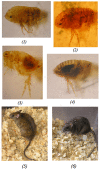Understanding the persistence of plague foci in Madagascar
- PMID: 24244760
- PMCID: PMC3820717
- DOI: 10.1371/journal.pntd.0002382
Understanding the persistence of plague foci in Madagascar
Abstract
Plague, a zoonosis caused by Yersinia pestis, is still found in Africa, Asia, and the Americas. Madagascar reports almost one third of the cases worldwide. Y. pestis can be encountered in three very different types of foci: urban, rural, and sylvatic. Flea vector and wild rodent host population dynamics are tightly correlated with modulation of climatic conditions, an association that could be crucial for both the maintenance of foci and human plague epidemics. The black rat Rattus rattus, the main host of Y. pestis in Madagascar, is found to exhibit high resistance to plague in endemic areas, opposing the concept of high mortality rates among rats exposed to the infection. Also, endemic fleas could play an essential role in maintenance of the foci. This review discusses recent advances in the understanding of the role of these factors as well as human behavior in the persistence of plague in Madagascar.
Conflict of interest statement
The authors have declared that no competing interests exist.
Figures



References
-
- Stenseth NC, Atshabar BB, Begon M, Belmain SR, Bertherat E, et al. (2008) Plague: past, present, and future. PLoS Med 5: e3 doi:10.1371/journal.pmed.0050003 - DOI - PMC - PubMed
-
- Duplantier JM, Duchemin JB, Chanteau S, Carniel E (2005) From the recent lessons of the Malagasy foci towards a global understanding of the factors involved in plague reemergence. Vet Res 36: 437–453. - PubMed
-
- Hinnebusch BJ (2005) The evolution of flea-borne transmission in Yersinia pestis . Curr Issues Mol Biol 7: 197–212. - PubMed
Publication types
MeSH terms
LinkOut - more resources
Full Text Sources
Other Literature Sources
Medical

